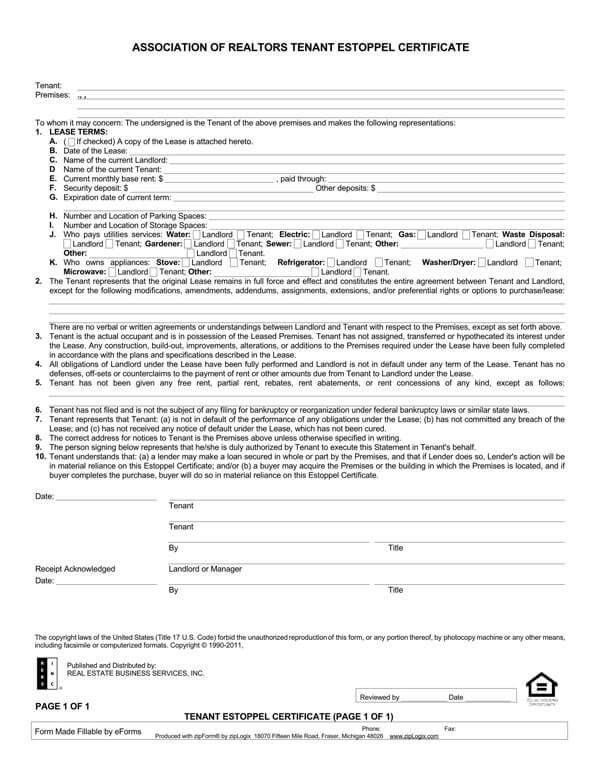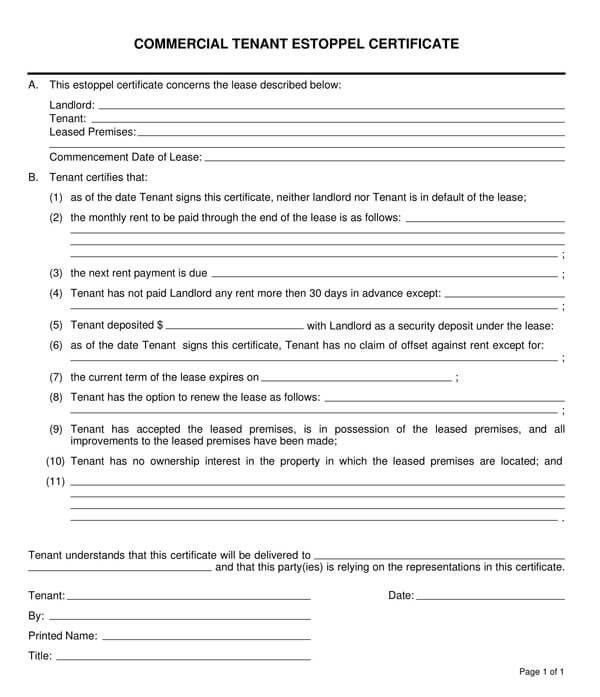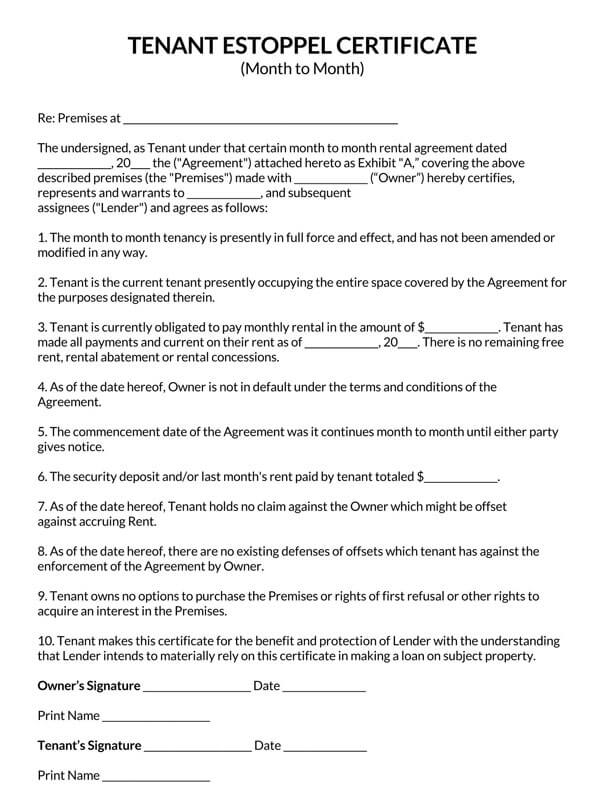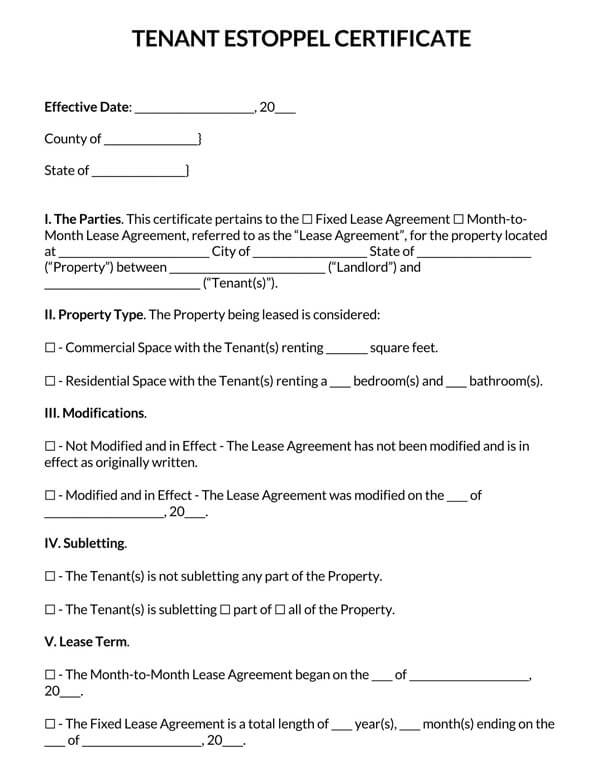A Tenant Estoppel Certificate is an agreement used to describe the current conditions of a lease agreement between a tenant and the property owner.
The tenant estoppel certificate describes important details about the rights and privileges of the current tenant (s) living in the rental property and establishes the relationship between the tenant and the property owner.
Alternative names for a tenant estoppel certificate include:
- Estoppel agreement
- Tenant Rental Information Declaration
- Rental Information Questionnaire
Purpose and Uses
A tenant estoppel certificate is used to inform all potential buyers of a commercial/residential rental property of the privileges and rights of existing tenants. The tenant estoppel certificate incorporates information about the rental amount, lease terms, oral agreements between the tenant and the property owner, protected tenancy status, amendments made on the original lease agreement, promises made by the property owner to the tenant and vice versa, and agreements concerning the payment of utilities such as cable, gas, electricity, and water.
Simply put, the tenant estoppel certificate is meant to describe the nature of the relationship between the property owner and the tenant and give guidance to potential buyers on the rights and privileges that the current tenants already enjoy.
Types of Tenant Estoppel Certificates
There are different tenant estoppel certificates; although they all serve the same purpose, they should be used for different scenarios.
They include:

Association of Realtors
An association of realtors’ estoppel certificate is a legal document obtained from a condominium owner’s association, a property’s governing homeowner’s association, or a related governing body that enlists the dues, assessments, and fees that a new tenant will be responsible for after leasing a property and what the current tenant owes.
Download: Microsoft Word (.docx)

Commercial Tenant Estoppel Certificate
A commercial tenant estoppel certificate reinforces the agreement between the commercial property owner and the tenant (s). It also expounds on the underlying lease agreement and provides a summary of important conditions in the lease agreement as well as the tenant’s rights and privileges.
Download: Microsoft Word (.docx)

Month-to-Month tenant
The purpose of a month-to-month tenant estoppel certificate is to give a prospective buyer or lender information about the lease agreement and the leased premises and provide an assurance to the lender or the purchaser that the tenant will not make claims that are not consistent with the statements enshrined in the estoppel.
Download: Microsoft Word (.docx)

Residential tenant
When selling the residential property, a property owner may request an estoppel certificate from their residential tenant (s). As part of the due diligence, the buyer will want to understand the lease agreement they will be inheriting from the current owner and tenant (s).
Download: Microsoft Word (.docx)
How do Landlords Get the Tenant Estoppel Certificate?
To obtain an estoppel certificate, the property owner must first understand in detail the characteristics of the original lease agreement to make it easy for the tenant to confirm their current lease and have it signed before a notary.
Below are the steps a property owner should take to obtain the tenant estoppel certificate:
Step 1: The property owner gets the original lease
The property owner must first go through the original lease agreement and review its terms and conditions, making sure to go through all the clauses keenly before they can complete the estoppel.
Some of the items that they must keenly review and include in the estoppel include:
- Rent amount and payment duration
- Expenses: Both their responsibilities and those of the tenant
- Lease term: The start and end date of the lease agreement and the renewal terms
- Subletting: The property owner must include in the estoppel whether the tenant has the right to sublet the rental property and the conditions that must be fulfilled to sublet.
- Security deposit amount: The security deposit paid by the tenant and the condition for refund must be included in the estoppel certificate
- Future rent: If the Tenant has made any prepayment on their rent, the amount must be included in the estoppel to be deducted at the closing
Step 2: The property owner verifies the tenant’s behavior
To help the new/potential owner understand whom they will be dealing with, the current property owner should provide comprehensive information on whether the tenant has ever been served with a default/eviction notice and attach any copies to the estoppel certificate along with the return receipt that was sent to the tenant.
Step 3: The property owner gets copies of the last three month’s rent
To prove to the potential buyer(s) that the tenant has been paying their rent- the actual rent amount included in the lease agreement, the property owner should obtain all the cheques, receipts, and any other proof of payment documents over the last three months and attach them to the estoppel.
Step 4: The property owner gets the certificate signed by the tenant in front of a notary
After all, the information required for the estoppel has been duly covered and verified to be accurate. Once the tenant has ascertained that the property owner has no further obligations due, they should sign the estoppel in the presence of a notary public to show that they acknowledge the contents of the tenant estoppel certificate. This will also ensure that no forgery can be done on the document as they will be required to present their identification card in front of the notary public to confirm their identity.
Key Components of the Tenant Estoppel Certificate
The components of tenant estoppel certificates usually vary with the type of information required by the potential buyer before closing. However, key components must be included in the estoppel certificate to ensure its validity.
These components include:
The commencement date of the lease agreement
The date on which the lease agreement commenced and the conditions for renewal
The date to which rent is paid
This is the date on which the tenant is required to have remitted their rent
Names of involved parties, the property in question, and the lease
The estoppel certificate should include the names of both the tenant and the property owner, a description of the property in question, and a breakdown of important provisions that relate directly to the relationship between the tenant and the property owner or a copy of the lease agreement should be attached to the estoppel certificate.
Verification of no defaults
A statement indicating that the tenant has never defaulted on any clause included in the lease agreement
Specification of any defaults found
If the Tenant defaulted on any clause in the lease agreement, such defaults should be mentioned in the estoppel and accompanied with supporting documents such as default notices.
Verification of the lease modification
If the original lease agreement was amended to incorporate certain aspects not covered in the original lease agreement, a verification document must be attached to show how it was amended. Such amendments must be clearly stipulated in the document.
Added statement for any modification
A declaratory statement should be included in the estoppel showing any other important information that the potential buyer should know of before buying the property.
Status of provisions
Key provisions of the lease agreement should categorically be quoted in the estoppel certificate and their status clearly defined to help the new owners understand specific rights and/or privileges that the tenant(s) enjoy.
Describe the lease agreement
A description of the lease agreement, i.e., monthly, weekly, semi-yearly, yearly, should be provided in the estoppel certificate to help the new owners understand how often the lease agreement should be renewed and the conditions that warrant automatic renewal or cancellation of the lease.
Signatures of all parties and notary acknowledgment
All the parties, i.e., the tenant and the property owner, should sign the certificate in front of a notary public showing that they acknowledge its contents. The notary public must also affirm and acknowledge the certificate by affixing their signature and seal on the document.
What is a Tenant Estoppel Certificate Form?
A tenant estoppel certificate form is a pre-built template that can be used to obtain information on the tenant and details about the lease agreement to help describe important details about the rights and privileges of the current tenant living in the rental property. The form can be filled accordingly by both the tenant and the property owner to help ease the writing process and ensure no critical information is missed.
Free Forms
Following are some free downloadable tenant estoppel certificate templates for you:
Frequently Asked Questions
Are tenants required to complete the estoppel certificate?
Tenants are required to sign an estoppel certificate where the written lease agreement contains a clause requiring that they do so. It may be considered a breach of the lease agreement if they refuse to do so when such stipulations are enshrined in the original lease agreement.
Should the tenant sign the estoppel certificate?
Several situations may require a tenant to sign an estoppel certificate even though such provisions may not have been originally included in the lease agreement. For instance, if the property owner agreed to allow the tenant to sublet, the tenant should list that in the estoppel to let the new owner know of this privilege. The tenant may also want to sign the estoppel certificate to inform potential buyers of any restrictions on the leased property in the event of a no-fault eviction.
What should tenants look for before signing the estoppel certificate?
The tenant must ensure that the information included in the estoppel certificate is true and accurate. The tenant must review their lease agreement carefully together with any other agreements they may have made with their current property owner before completing the estoppel certificate. They should also ensure that the original lease agreement and all pertinent documents are included in the estoppel certificate.
What is the risk of signing an estoppel certificate?
If estoppel is not filled out properly, it may present several risks to the tenant. However, if it is accurately filled, problems may not arise. Although not common, tenants can get sued for not providing accurate or enough information on the estoppel. To avoid any issues after signing the estoppel, the tenant should be very keen when signing the estoppel, and they should ensure that all the information included in the estoppel is true, accurate and complete.
What if the Real Estate Agent does not forward the Estoppel certificate to the potential buyer?
Under the California Civil Code § 2079.16, the real estate agent must provide the prospective buyers with the estoppel certificate. Consequently, the prospective buyer can recover damages against a seller or real estate agent who submits an erroneous estoppel certificate.


